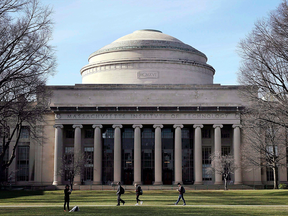Article content
MIT has just published the demographic breakdown of its undergraduate class of 2028, the first admitted after the United States Supreme Court’s decision last year striking down affirmative action. The use of racial preferences in university and college admissions, the court ruled last June, was unconstitutional. As Chief Justice John Roberts wrote, “The student must be treated based on his or her experiences as an individual — not on the basis of race.”
Article content
Following the affirmative action ban, relative to the previous four years’ average, the proportion of Asian-American students admitted to MIT rose to 47 per cent from 41 per cent, the proportion of Black/African-American students fell to five per cent from 13 per cent, and the proportion of Hispanic/Latino students fell to 11 per cent from 15 per cent. The proportion of students who were white/Caucasian was roughly unchanged at 37 per cent versus an average of 38 per cent over the previous four years. Still other students reported other racial backgrounds, with the totals exceeding 100 per cent as students were permitted to report multiple ethnicities.
These numbers strongly suggest that under the previous affirmative action regime, Asian-Americans were discriminated against based on their race while some Black/African-American and Hispanic/Latino students were admitted on the basis of racial preference. Although factors besides the Supreme Court ruling affect the demographic breakdown of admissions, MIT’s dean of admissions effectively confirmed this unequal treatment based on race by stating that the expected impact of the court’s ruling would be a decline in the number of students from “historically underrepresented racial and ethnic groups” (though the term “underrepresented” is obviously fraught).
Article content
Other evidence confirms a high degree of racial discrimination at other schools under the old affirmative action regime. From 2010 to 2015, excluding “legacy students” and recruited athletes, a student in the top academic decile had a nearly 60 per cent chance of being admitted to Harvard if Black, about 35 per cent if Hispanic, less than 20 per cent if white, and less than 15 per cent if Asian. In fact, a Black student whose academic ranking was just below average had almost twice as much chance of being admitted to Harvard as an Asian student whose academic ranking was in the top 10 per cent.
American economist Thomas Sowell has long studied the disastrous impacts of affirmative action and was quoted extensively in Justice Clarence Thomas’s concurring opinion in the Supreme Court case striking it down. In his 2023 book Social Justice Fallacies, he highlighted, among many examples, the unhappy consequences of MIT’s practice of affirmative action in decades past.
Although the average Black student at MIT was “in the top 10 per cent of American students in mathematics, they were in the bottom 10 per cent of students at MIT, whose students’ math scores were at the 99th percentile,” Sowell explained, citing a 1987 article. “The outcome was that 24 per cent of these extremely well-qualified black students failed to graduate at MIT, and those who did graduate were concentrated in the lower half of their class.”
Article content
While these Black students could have been near the top of the class in most universities, admitting them to MIT based on race instead of academic readiness set them up to fail. In the same vein, Sowell recalls that when he taught at Cornell a huge inflow of Black students in the 1960s as a result of race-based programs ended in half of Black students being put on probation for academic deficiencies. More recent national data show these negative impacts of affirmative action were not confined to MIT and Cornell and have persisted across the decades.
Black students admitted to top schools based on academic merit also suffered negative impacts from affirmative action. Applying the latest MIT admissions data crudely, under the previous affirmative action regime, only five in every 13 Black undergraduate MIT students were admitted on merit. The unavoidable consequence is that many who were admitted on merit would nevertheless have had many of their peers and teachers initially assume, or at least strongly suspect, they were admitted based on race and adjust their expectations accordingly. That helps no one.
Article content
The Wikipedia description of “affirmative action” reads: “Affirmative action is intended to alleviate under-representation and to promote the opportunities of defined minority groups within a society to give them access equal to that of the majority population.” Sowell’s reply in an interview last year: “Well, there are always wonderful words to describe things that are not very wonderful.” Racial discrimination is indeed not wonderful, and students of all races are better off with this practice banned from university admissions.
Share this article in your social network



